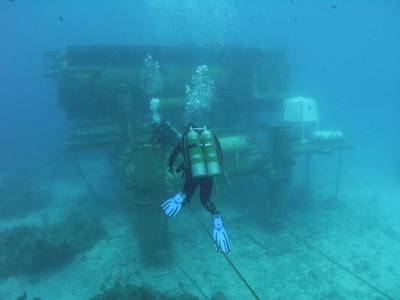The Earth’s oceans are a vast frontier that brims with possibilities for the future of medicine, ocean conservation, and food production. They remain largely unexplored because of the physical limits of scuba diving. Humans can only dive for a few hours each day, and every minute spent breathing compressed air at depth must be paid for with a slower ascent to the surface. Otherwise, divers could develop decompression sickness from nitrogen expanding in the bloodstream.
In the 1960s, world-famous oceanographer Jacques Cousteau built a series of small underwater habitats to extend the time that he and other researchers were able to work. These sea labs were tethered to a support ship with a cable that provided air and power.
Cousteau’s first sea lab, Conshelf 1 (Continental Shelf Station) held two people and was stationed 33 feet deep off the coast of Marseilles, France. Conshelf 2 sheltered six people and spent a total of six weeks under the Red Sea at two different depths.
Conshelf 3 was Cousteau’s most ambitious habitat design, because it was nearly self-sufficient compared to the first two. It accommodated six divers for three weeks at a time and sat 336 feet deep off the coast of France, near Nice. Conshelf 3 was built in partnership with a French petrochemical company to study the viability of stationing humans for underwater oil drilling (before we had robots for that), and included a mock oil rig on the nearby ocean floor for exercises.
Several underwater habitats have come and gone in the years since the Conshelf series, but each has been built for a specific research project or group of tasks. There’s never really been a permanent habitat established for general research into the biochemistry of the ocean.
Jacques Cousteau’s grandson Fabien believes the luxury lab’s time has come. He’s in the process of raising $135 million USD to build and launch what would be one of the largest underwater habitats in existence. Cousteau and his partners are looking to build a marine version of the International Space Station — a long-term livable habitat that can support a dozen researchers for several weeks at a stretch. The new lab will be called Proteus after the shape-shifting Greek god who could see the future, but answered only to those who could capture him.

The largest existing underwater habitat still in operation today is the Aquarius Reef Base, which was built in 1986 and is about the size of a school bus. Aquarius is parked 62 feet deep and roughly 5.5 miles off the coast of Key Largo, Florida, which makes it …read more
Source:: Hackaday

